Advances in Microfluidic Single-Cell RNA Sequencing and Spatial Transcriptomics
- PMID: 40283301
- PMCID: PMC12029715
- DOI: 10.3390/mi16040426
Advances in Microfluidic Single-Cell RNA Sequencing and Spatial Transcriptomics
Abstract
The development of micro- and nano-fabrication technologies has greatly advanced single-cell and spatial omics technologies. With the advantages of integration and compartmentalization, microfluidic chips are capable of generating high-throughput parallel reaction systems for single-cell screening and analysis. As omics technologies improve, microfluidic chips can now integrate promising transcriptomics technologies, providing new insights from molecular characterization for tissue gene expression profiles and further revealing the static and even dynamic processes of tissues in homeostasis and disease. Here, we survey the current landscape of microfluidic methods in the field of single-cell and spatial multi-omics, as well as assessing their relative advantages and limitations. We highlight how microfluidics has been adapted and improved to provide new insights into multi-omics over the past decade. Last, we emphasize the contributions of microfluidic-based omics methods in development, neuroscience, and disease mechanisms, as well as further revealing some perspectives for technological advances in translational and clinical medicine.
Keywords: microfluidics; single cell; single-cell RNA sequencing (scRNA-seq); spatial transcriptome.
Conflict of interest statement
The authors declare no conflict of interest.
Figures








Similar articles
-
Microfluidic single-cell transcriptomics: moving towards multimodal and spatiotemporal omics.Lab Chip. 2021 Oct 12;21(20):3829-3849. doi: 10.1039/d1lc00607j. Lab Chip. 2021. PMID: 34541590 Review.
-
Recent advances in high-throughput single-cell transcriptomics and spatial transcriptomics.Lab Chip. 2022 Dec 6;22(24):4774-4791. doi: 10.1039/d2lc00633b. Lab Chip. 2022. PMID: 36254761 Review.
-
Spatial Omics Sequencing Based on Microfluidic Array Chips.Biosensors (Basel). 2023 Jul 6;13(7):712. doi: 10.3390/bios13070712. Biosensors (Basel). 2023. PMID: 37504111 Free PMC article. Review.
-
Hydrop enables droplet-based single-cell ATAC-seq and single-cell RNA-seq using dissolvable hydrogel beads.Elife. 2022 Feb 23;11:e73971. doi: 10.7554/eLife.73971. Elife. 2022. PMID: 35195064 Free PMC article.
-
Computational solutions for spatial transcriptomics.Comput Struct Biotechnol J. 2022 Sep 1;20:4870-4884. doi: 10.1016/j.csbj.2022.08.043. eCollection 2022. Comput Struct Biotechnol J. 2022. PMID: 36147664 Free PMC article. Review.
Cited by
-
Digital Alchemy: The Rise of Machine and Deep Learning in Small-Molecule Drug Discovery.Int J Mol Sci. 2025 Jul 16;26(14):6807. doi: 10.3390/ijms26146807. Int J Mol Sci. 2025. PMID: 40725054 Free PMC article. Review.
-
Role of Cellular Senescence in Parkinson's Disease: Potential for Disease-Modification Through Senotherapy.Biomedicines. 2025 Jun 7;13(6):1400. doi: 10.3390/biomedicines13061400. Biomedicines. 2025. PMID: 40564120 Free PMC article. Review.
References
Publication types
Grants and funding
LinkOut - more resources
Full Text Sources
Research Materials
Miscellaneous

